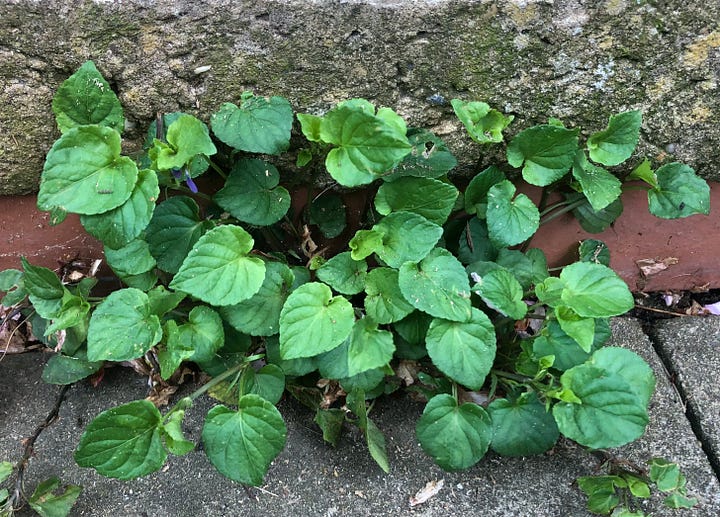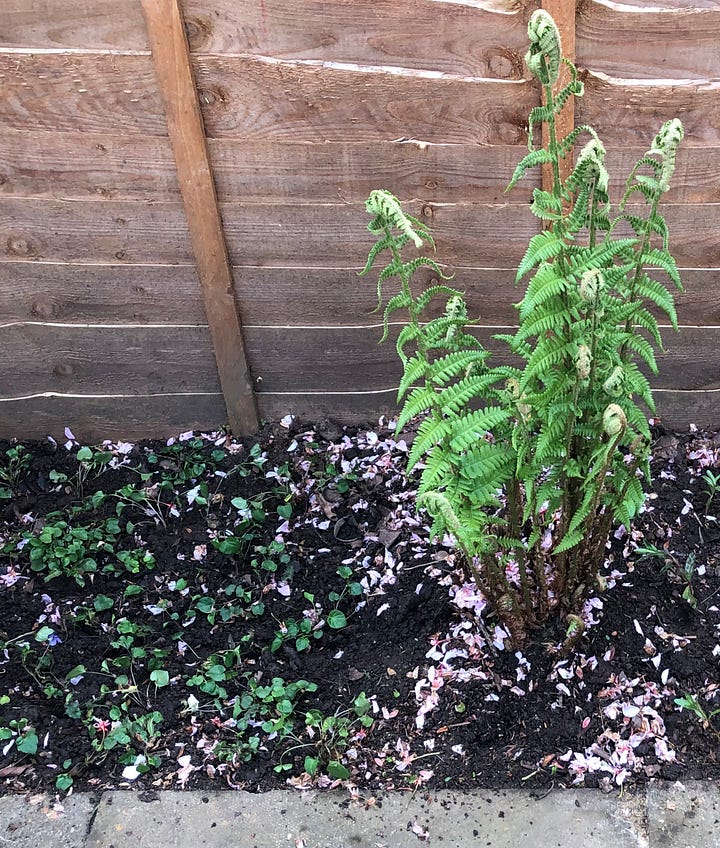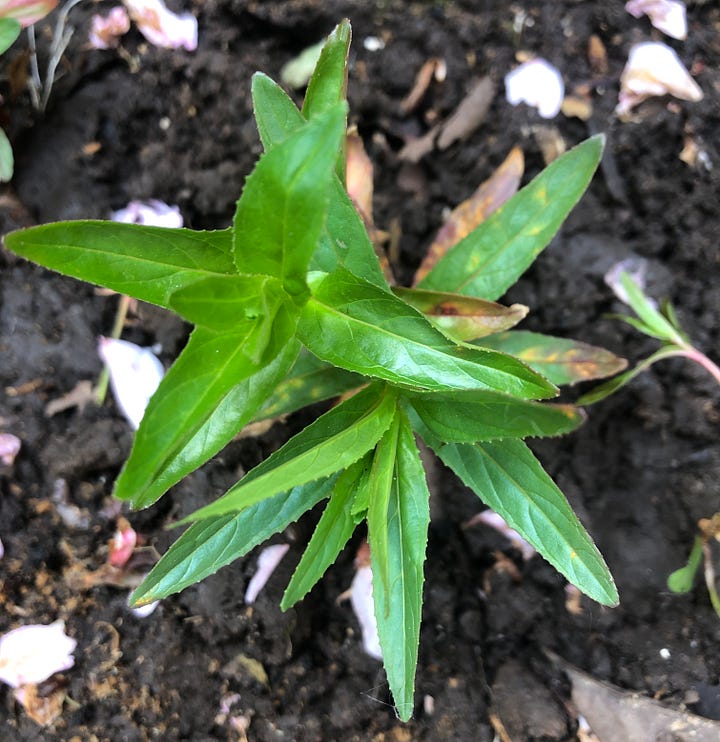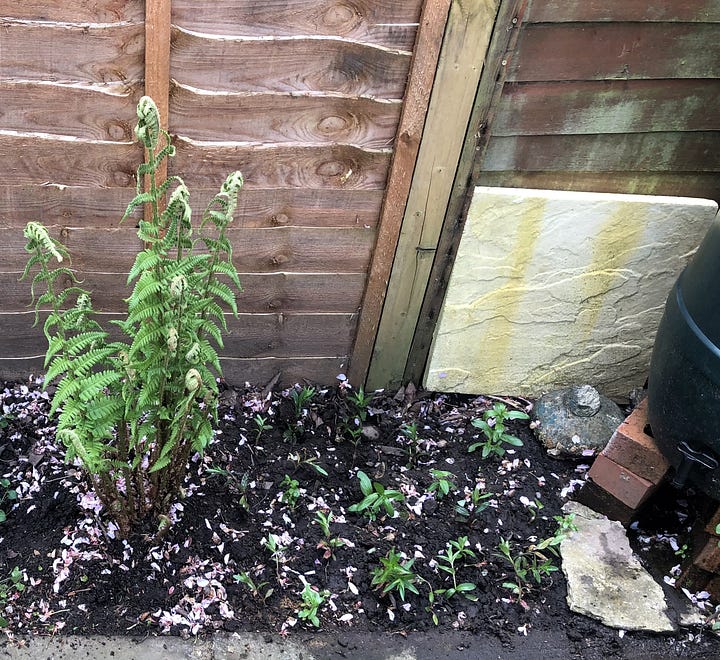Delicate sprays of snow white flowers glittered edges, layered roundels of fine feathered petals illuminated corners and triplets of Irish green leaves opened their hearts to cushion gently blushing blooms.
That this stunning display occurred naturally in her garden, with no effort required, was almost magical.
No wonder the butterflies, bees and moths flocked to these beautiful … weeds!
The RHS define a weed as ‘a plant that is growing where it isn’t wanted’.
It explains that they do this because they ‘thrive in average garden conditions, reproducing and spreading easily’.
And it advises, ‘It’s up to you to decide what you consider to be a weed and what you want to keep or remove.’
The plants I’ve described in the opening are wavy bittercress (cardamine flexuosa), dandelions (taraxacum) and pink wood-sorrel (oxalis debilis) which are categorised by many people as weeds. But for the rest of this article, I am going to refer to plants like this as ‘wild plants’.
I think most wild plants should be embraced because they’re free, they’re beautiful and they’re good for biodiversity!
And I am not the only one.
Gertrude Jekyll and wild plants
‘heavy on the herbaceous, lots of wild plants allowed to do their thing.’
‘…she was an artist but she also brought together the two rowing camps of garden designers: those that liked formality and the others, the late Victorians, who wanted to kick back, push against industrialisation and felt that gardens should be left to go wild.’
Toby Young on Gertrude Jekyll’s design of the Vann Garden in Surrey
Gardeners’ World, 12.4.24, 37.45
Inspired by renowned horticulturist and garden designer Gertrude Jekyll, I’ve begun to use some of my naturally occurring wild plants more formally in my garden. I started by lifting some haphazardly self-seeded wavy bittercress and replanting them in more formal designs.
According to the RHS, Bittercress is a UK native wildflower, that attracts moths, butterflies and hoverflies. It can also be eaten by humans as part of a salad as it has a peppery, cress-like flavour!
I queued some bittercress up in a vertical line to create a boundary between the lawn and a border.
And I grouped some more at the front of another border in a neat rectangle.
I didn’t stop there!
Not all wildflowers come from a seed packet
Because it was previously neglected, my garden is already home to a variety of wildflowers that I’m just starting to discover, identify and appreciate.
Previously I’ve tried and failed to grow wildflowers from scatter packs or packets of ‘professional’ wildflower seed mixes.
It turns out that the ‘designer’ wildflowers (poppies, cornflowers, larkspur etc) grow best in ‘low-quality soil’ - though I don’t ever remember reading that in the planting instructions!
So I’ve stopped striving for something that will probably never thrive in my rich, clay soil and instead, I experiment with what I’ve got! There are many common dog violets (viola riviniana) growing in my garden, for example. These small but exquisite wild plants have emerald green, heart-shaped leaves and tiny unscented five-petalled purple flowers.


I’ve left the few fringing the bottom of the house in situ, but I’ve moved those growing between the paving slabs. I have carpeted them next to a majestic fern (dryopteris filix-max). The fern will soon spread its wings over their heads recreating the woodland habitat they are used to. I hope the violets will provide some low-growing, lush ground cover and perhaps attract rare butterflies like the silver-washed/high brown/dark green fritillary.
On the other side of the fern, I’ve decided to populate the sodden ‘dead space’ next to the water butt with square-stemmed willowherb (epilobium tetragonum). This grows all over my garden and (also in the gutters!) so I’m pretty confident it will thrive here.
I’m hoping I’ll enjoy its unusual cross-shaped flowers - which I’ve never seen as I’ve always weeded these out previously! I also hope, that as they can grow quite tall, the willowherb will soften and disguise this slightly messy corner of the garden.


To experiment with, rather than remove, wild plants select the abundant and attractive ones that tie in with your colour palette.
Then carefully dig them up and reposition them, in a more uniform pattern, in another part of your garden that has similar conditions to the original site. The pollinators will get more out of these plants growing in your garden rather than decomposing in your compost heap!
Make sure your wild plants are safe however!
When bringing in or working with any wild plants in your garden, make sure you are confident that you know what they are and that they are safe.
Recently, I spotted a few of these plants popping up in my garden:
By using the PlantNet app and doing some googling, I think it’s probably hogweed (heracleum sphondylium) though worse case scenario it could be giant hogweed (heracleum mantegazzianum).
According to the RHS, giant hogweed is ‘invasive and potentially harmful. Chemicals in the sap can cause photodermatitis or photosensitivity, where the skin becomes very sensitive to sunlight and may suffer blistering, pigmentation and long-lasting scars.’
Eeek!
Even if my hogweed isn’t the giant kind and doesn’t carry the same health warnings, it’s still described as ‘potentially harmful TOXIC to skin in sunlight’.
Because I’m not one hundred percent sure what I have, I read through all of the RHS advice, covered my hands, arms and face, dug up these wild plants and buried them deep in my compost heap. And then washed my hands, my clothing and tools afterwards.
No Mow May
‘ … with our current obsession with lawn hygiene… in the UK we’ve lost nearly 7.5 million acres of flower-rich meadow and pasture since the 1930s and now only one percent, a tiny one percent, of our countryside provides the flowers that are so essential for pollinating insects… so if we all team up and allow the old fashioned wildflowers to grow back, we could really make a difference…. to support the bees and other insects that in turn support everything higher up the food chain ...’
Juliet Sargeant, GQT at Home: No Mow May and Dahlia Decay, 07.05.21, 30.30
No Mow May is a campaign run by Plantlife that encourages you to let wild plants grow in your lawn.
As well as supporting pollinators if you don’t mow in May, your lawn can also help tackle pollution, reduce urban heat extremes, and lock away atmospheric carbon!
And although the campaign is called ‘No Mow May’, you don’t need to follow this instruction to the letter, you can make it work for you.
Leave your entire lawn in May and for the rest of the summer if you can, or resume mowing after May but be more relaxed about it. Let the grass and wildflowers grow taller and mow less.
Or you can continue to mow some parts of your garden but leave other areas longer. I have a mown area (for sunbathing, lounging and reading!) and an area for wildlife that I don’t ever weed or mow, (whether it’s May or not!)
And if you are going to let some or all of your lawn grow but still want it to be aesthetically pleasing, according to the experts on GQT, just look after your edges:
‘… to make it look good… to make it look intentional … mow around the edges, so mow like a metre strip short … (or) the other thing to do is mow a wavy path through it if it’s a decent size lawn … it can look really, really nice.’
Matthew Pottage, GQT Ludlow, 06.05.22, 29.30
‘I sometimes make woven hazel arches, low ones, along the edge of the longer bit to keep the stuff from flopping over: touches like that add structure and interest and keep it looking a bit more kempt.’
Bunny Guinness, GQT Ludlow, 06.05.22, 31.18
‘It’s the edges that are important, if you trim the edges where they’re against the borders and make them look neat, the whole thing looks fantastic.’
Bob Flowerdew, GQT At Home: Episode 7, 15.05.20, 12.15
To safely embrace wild plants in your garden, find out what you have, and ONLY if they are safe to remain, consider replanting them in more formal patterns, move them into your borders and edges, use them to soften things like water butts and help them to thrive in your lawn by taking part in No Mow May.








